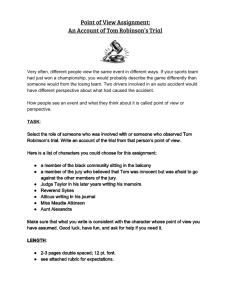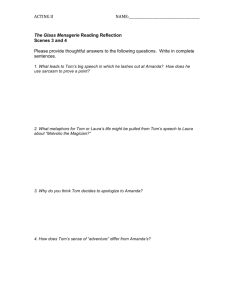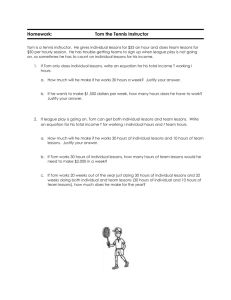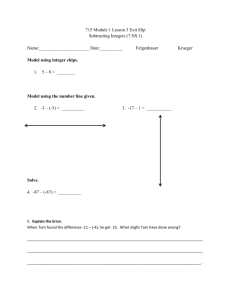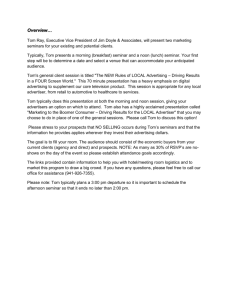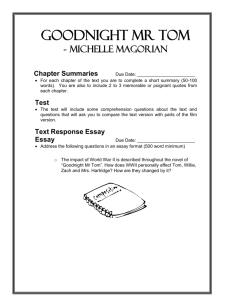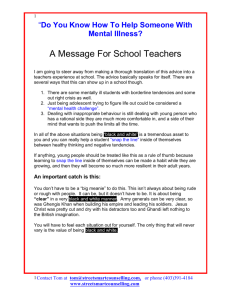Theory of Mind and the Self by: Francesca Happe
advertisement
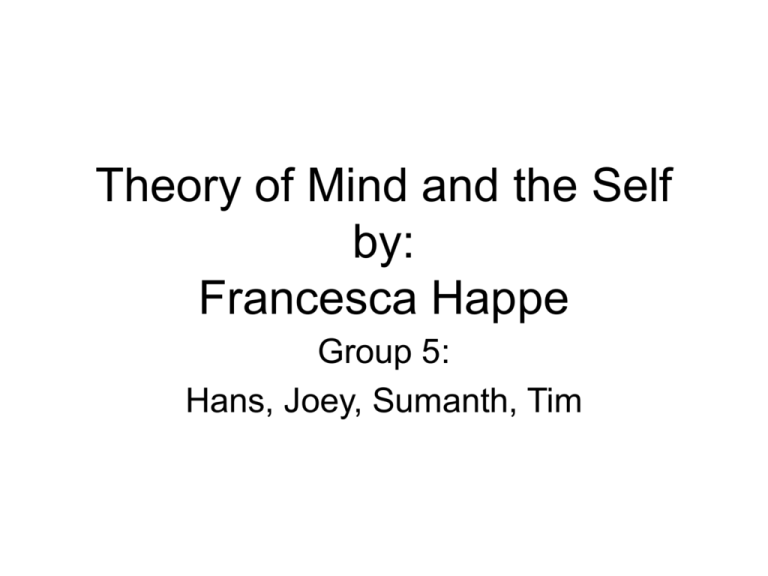
Theory of Mind and the Self by: Francesca Happe Group 5: Hans, Joey, Sumanth, Tim Outline Theory of mind and the self Theory of own mind and theory of other minds Autism-a disorder of “Theory of Mind” fMRI studies of Theory of Mind and self-reflection What is ToM? • Theory of mind refers to the everyday ability to attribute independent mental states to self and others in order to predict or explain behavior • These thoughts are normal for social interaction: – Example: we make sense of people’s behavior via belief-desire psychology • It’s easy to explain why Jon will carry an umbrella with him, because believes it will rain and wants to stay dry Cognitive Processes of ToM • Some favor a more general explanation – Simulation, general theory building • Others argue for the necessity of a dedicated cognitive mechanism – Innate mechanism: supported by a relative lack of normal individual difference or cross-cultural variation, and an acquisition of ToM early in childhood – They also mention that even though it is innate, it needs triggering input, like social interactions Testing ToM • The litmus test – Attributing false beliefs – Where prediction and explanation of action cannot be based simply on the state of the world • To pass the test, one must keep particular beliefs of another person separate from their own beliefs Testing Continued • Children are tested at only 3-4 and older due to the high verbal and executive task demands • Sally-Anne Task – A location change task • Smarties Task – A content change task Theory of Own Mind and Theory of Other Mind • Are the same mechanisms involved for ToM and ToOM? • There are different input channels – But it is crucial to distinguish mental states from representations of reality – Keeping reality separate from belief Theory of Other’s Minds • For example: it’s necessary to distinguish the represenations of the reality that “there is a pencil in the tube” from the representation of belief that, I “thought there are sweets in the tube” • From here we can postulate that the same mechanism involved in keeping mental states separate from reality does not change depending if these states are you “own” states or others’ states Leslie (1987) • He suggested that understanding of pretense in infancy demonstrates the availability of a special form of representation for mental states – He describes that there is a separation between first-order representations and meta-representations of real world states • Meta-representation is necessary to attribute mental states ToOM • Underlying our social understanding must be representations that capture who is thinking what and in what sense they are thinking it • When children are able to report their mental state, they are also able to report the mental states of others Autism • Autistic children seem to lack the ability to attribute mental states • These children also lack pretend play – This observation led researchers to believe meta-representation may be impaired and cannot conceptualize mental states; thus ToM deficits Autism • It is important to note that these individuals do not lack mental states, but are unable to reflect on their own mental states. • Asperger Syndrome are almost as good as controls when it comes to the more basic theory of mind tasks. Autism • Baron-Cohen (1993) • Method: – 2 groups – 16 (high functioning + ASP) – 16 (controls) – Matched gender/age – Basically a fill in the last box of a comic exp Baron-Cohen Results • A character intention (CI) condition • A physical causality (PC) • The ASP did much better in the PC condition than in the CI condition. (p<0.001) • ASP did as well as controls in the false-belief tasks. Autism and ToM • It is easy to study lack of ToM regarding other peoples mindstates. • However, it is hard to evaluate in experimental situations the inability of autistics to know their own mindstate. • What kind of experiments can you do in the future? Weak Central Coherence Theory The limited ability to see the context and the big picture. The theory tries to explain why Autistics have skills in some areas. The contention is that Autistics may not see the bigger picture but they see details pretty well. Results Results Amygdala Frontal Lobe -Emotional Learning -Planning -Problem with this -Working Memory experiment -Binding Anterior Cingulate -Interpreter? -NOT lit up with autistic people Results 1) The same areas activated when subjects reflected on their own inner states -there is a overlap of brain networks 2) Baseline minds are introspective 3) Areas of ToM that are activated were not the same areas where mirror neurons are typically found. Where To Go From Here What else can we find out? -Look for people with brain lesions -Find individuals who can report on own mental states but not others -vice versa Where To Go From Here Why do we have a ToM? -Fitness Advantages -Evolved from humans being social creatures -Do animals have ToM? -Learning Where To Go From Here Does ToM always keep going? -ToM gets more accurate the more social situations we are placed in -Why old people are senile? -Is there a plateau? Where To Go From Here Is ToM innate? Is ToOM innate? Which came first?


